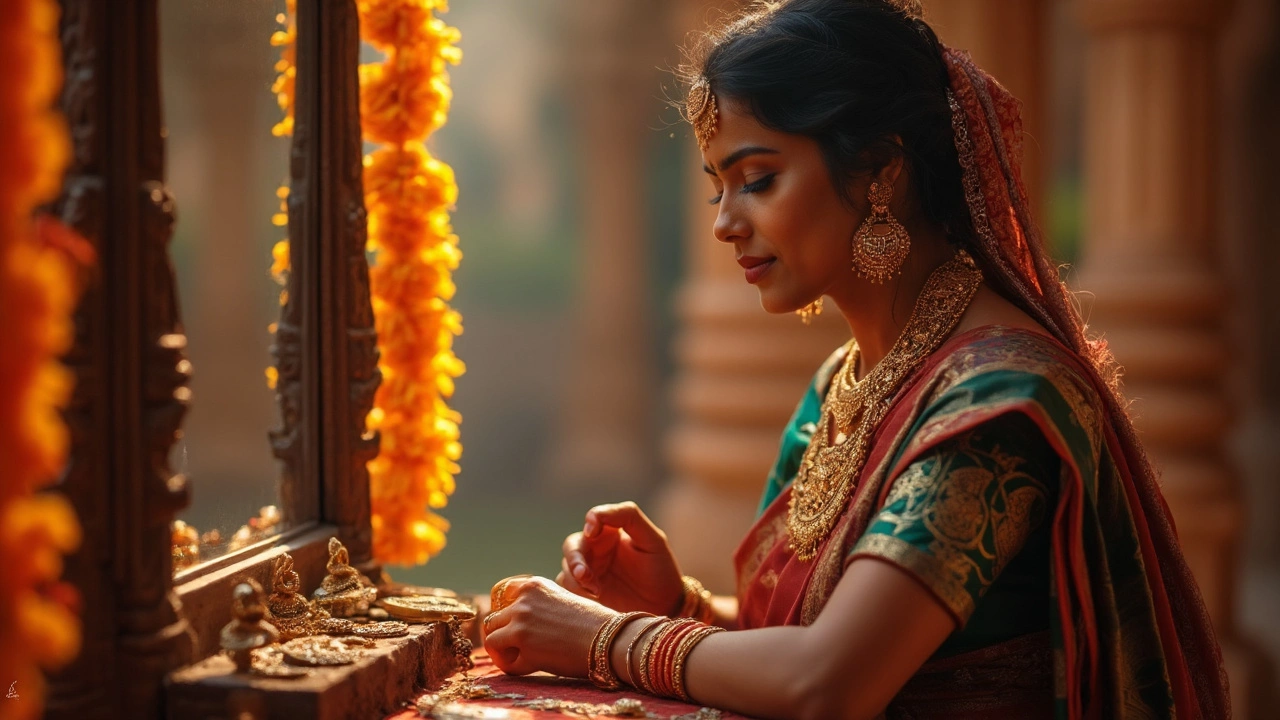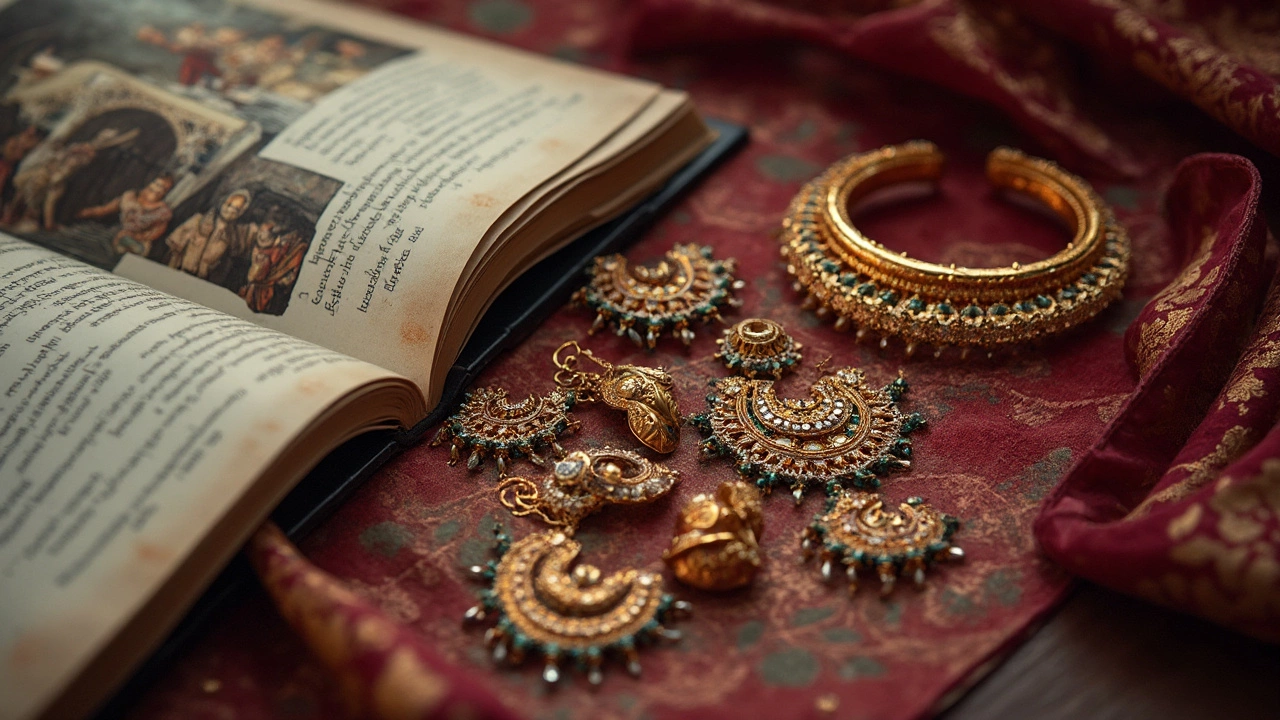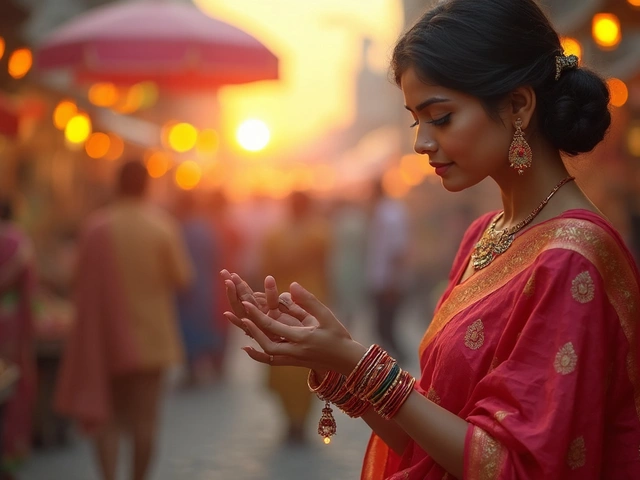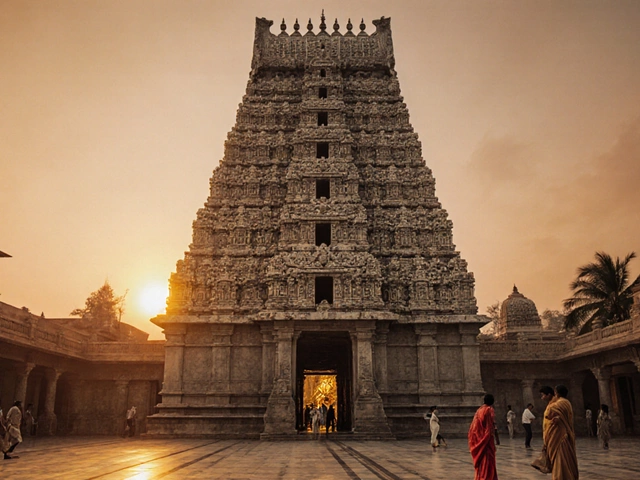
Walk into any Indian ceremony, and the first thing you notice is the sparkle—everywhere. Those ornate gold earrings and chunky necklaces? They’re not just “jewelry.” In India, these pieces actually have special names: 'temple jewellery' tops the list, especially when you’re talking about the bold, detailed stuff often seen on dancers and brides.
Temple jewellery isn’t something you just pick up at a mall. It’s rooted in centuries-old tradition. These ornaments were first made for decorating Hindu deities in temples—and later, dancers and regular folks started wearing them for weddings, festivals, and family events.
Wondering how to spot the real deal? Start with the motifs—look for gods, goddesses, peacocks, and lotuses, all sculpted out of chunky gold. The craftsmanship isn’t machine-made; it’s hand-carved and feels a bit heavier. That’s a dead giveaway if you’re hunting for authenticity.
- The Real Names of Traditional Indian Jewelry
- Temple Jewelry: The Sacred Connection
- How to Identify Traditional Pieces
- Materials and Craftsmanship
- Wearing Temple Jewelry Today
- Buying and Caring for Authentic Pieces
The Real Names of Traditional Indian Jewelry
If you think all Indian jewelry is just called 'gold jewelry,' think again. There’s a detailed system of names for every style and piece. The most iconic is temple jewellery, which kicked off in southern India. You’ll see items like heavy necklaces called 'haarams,' large earrings known as 'jhumkas,' and chains for the waist called 'vaddanams.'
Each region in India brings its own flavor to the jewelry scene. For example:
- Temple Jewellery: Often seen in classical dance and weddings. Used to decorate idols, then picked up by real people.
- Kundan: Famous in Rajasthan. Made by sticking cut gems with gold foil.
- Polki: Also from Rajasthan, but known for its uncut diamonds.
- Jadau: Easily spotted in Gujarat and Hyderabad—mixes gold with precious stones, always handcrafted.
- Meenakari: Vivid, enameled colors, especially red and green.
- Navratna: Set with nine gems, worn for good luck and health.
Here’s a quick breakdown showing how these styles stack up in popularity, use cases, and main features:
| Style | Region | Main Material | Common Uses |
|---|---|---|---|
| Temple Jewellery | South India | Gold | Weddings, Dance, Festivals |
| Kundan | Rajasthan | Gold, Gems | Weddings, Royal Wear |
| Polki | Rajasthan | Uncut Diamonds | Bridal, High-End Events |
| Jadau | Gujarat, Hyderabad | Gold, Precious Stones | Ceremonial |
| Meenakari | Jaipur | Gold, Enamel | Daily, Festive |
| Navratna | Pan-India | Various Gems | Auspicious Occasions |
Ever wondered why so many pieces have such detailed names? It’s totally practical. Each piece has a different look, meaning, and sometimes a specific event where it’s worn. The Indian Ministry of Textiles says,
"Traditional jewelry in India is more than just an ornament; it tells stories of the culture, social status, and family legacy."
This isn’t just fashion—it’s identity, custom, and even spirituality in metal and stone. If you’re shopping, knowing these real names can save you from falling for knockoffs. Plus, it’ll impress the store owner when you ask for a jhumka instead of ‘those dangly earrings.’
Temple Jewelry: The Sacred Connection
Temple jewelry isn’t just for looks. It started out as literal offerings—crafted to decorate Hindu gods and goddesses in South Indian temples. You’ll see the roots of this tradition most clearly in Tamil Nadu and Kerala, where local goldsmiths have passed down secret techniques for generations. The oldest styles are made with pure gold and are sometimes set with rubies or green stones that catch the light in temple halls.
Here’s something cool: the famous Bharatanatyam and Kuchipudi dancers don the very same style of jewelry, directly inspired by the pieces worn by deities. When dancers dress up, every necklace and earring isn’t just an accessory—it's part of their identity, telling a story and showing a link to Indian spirituality and art.
Temple jewelry typically features figures of Lakshmi (the goddess of wealth), Ganesha (the elephant god), and traditional symbols like mangoes and peacocks. When you spot these, you know you’re looking at something more than regular gold ornaments. It's no wonder families treasure these items as heirlooms, passing them down to the next generation.
The most important thing to know? Temple jewellery still holds deep cultural meaning. These pieces go everywhere from elaborate weddings to temple festivals. Wearing them is seen as a way to attract luck, blessings, and keep a bit of tradition alive—no matter where you are in the world.
How to Identify Traditional Pieces
If you’re searching for real traditional Indian jewelry, details make all the difference. It goes way beyond shiny gold—think of it as a cue card for Indian culture and history right there on your wrist or neck.
The key sign? Look for designs inspired by what you’d see in South Indian temples: elephant heads, goddess Lakshmi sitting on a lotus, peacocks, and even little temple bells are popular. Classic temple jewellery usually sticks to pure gold or silver, but sometimes you’ll see red rubies and green emeralds set into chunky pendants or earrings. These aren’t random stones; many of them are carefully picked because they show up well during rituals or performances.
Temple jewelry is more than adornment—it's a symbol of spirituality and craftsmanship. Every motif tells a story. — Dr. Vidya Dehejia, art historian
Another big giveaway is the weight. Temple jewellery isn’t light. Real pieces tend to feel hefty because of the thick gold and detailed layers. If something looks detailed but feels flimsy, it’s probably not the real thing.
Spotting genuine craftsmanship is easier when you know what to check for:
- Material: Authentic temple jewelry uses 22-karat gold or sterling silver. No plated stuff here.
- Hand-Carved Details: Each motif, especially gods or goddesses, looks like it’s been etched, not stamped.
- Stone Setting: Gemstones are set into the metal, not glued on top. You won’t see any odd gaps or obvious adhesive.
- Traditional Shapes: Designs like vanki (armbands), jhumka (bell-shaped earrings), and maang tikka (forehead piece) are common.
Let’s look at common differences between traditional and modern imitation pieces:
| Feature | Traditional Temple Jewellery | Modern Imitations |
|---|---|---|
| Main Material | 22k Gold / Sterling Silver | Gold-Plated Alloy |
| Weight | Heavy, solid feel | Light, sometimes hollow |
| Gemstone Setting | Stone is set in metal | Stone is glued on |
| Motifs | Religious, cultural icons | Generic or trendy shapes |
If you’re ever in doubt, ask for certification. Reputable jewelers in India, especially in Chennai or Hyderabad, will happily show you proof of the gold’s purity. Temple jewelry almost always comes with a story—if the shopkeeper can’t tell you one, it’s probably not the real deal.

Materials and Craftsmanship
The first thing that stands out about traditional Indian jewelry—especially temple jewellery—is its use of gold. Most real temple pieces are crafted from pure gold or, sometimes, silver that's gold-plated. While the weight might surprise newcomers, it’s actually a sign of quality because flimsy jewelry won’t hold those intricate designs for long.
Traditional makers still use old-school methods. Pieces are mostly handmade, not churned out by machines. Artisans carve tiny details using tools passed down through generations. The results? No two pieces are exactly the same. Each necklace, earring, or bangle feels unique. If you spot filigree (those lace-like patterns), tiny bells, or stone inlays, you’re looking at some serious handiwork.
When it comes to decorations, temple jewellery uses gemstones like rubies, emeralds, and pearls. These aren't just thrown in for color—they each have a meaning or story in Indian culture. For example, red stones often stand for passion or prosperity, while pearls are linked to purity. You’ll also see motifs like goddesses, elephants, and flowers hammered or cast into almost every piece.
Here’s a quick breakdown of the most common materials:
- Gold (22K is the most popular)
- Silver (especially for those who want something lighter or cheaper)
- Rubies, emeralds, and other semi-precious stones
- Pearls, either natural or cultured
- Enamel for extra color
Curious about what sets handmade apart from machine-made? Take a look at this comparison:
| Handmade | Machine-made |
|---|---|
| Unique details, every piece slightly different | Perfectly uniform, but less character |
| Heavier, sturdier build | Lighter and often less durable |
| Traditional techniques, more time-consuming | Faster production, lower costs |
| Sought after for weddings and special events | Common for everyday use |
If you want something that lasts and carries a story, go for handmade. For anything mass-produced, you’re usually looking at stamped or laser-cut designs, which don’t have the same depth or personal touch.
Wearing Temple Jewelry Today
Back in the day, temple jewelry was reserved for royalty, devout families, and classical dancers. Fast forward to now, and you’ll see it everywhere: weddings, festivals, college graduations, and even runway shows. It’s not locked away in vaults—it’s become wearable art for all sorts of events.
Women usually pair chunky necklaces and bold jhumka earrings with sarees or lehengas. South Indian brides particularly love this style; actually, in Kerala and Tamil Nadu, it’s almost an unspoken wedding rule. Grooms sometimes rock a pendant or brooch with a similar look.
What’s surprising? These days, people are mixing temple jewelry with Indo-western and even casual outfits. You’ll see someone at a party wearing jeans and a plain top—then there’s this massive gold-finish choker making a statement. It’s all about picking one standout piece and letting it shine.
If you’re thinking of trying out traditional Indian jewelry, here’s what you should keep in mind:
- Match the metal with your outfit—temple jewelry is usually gold-toned, but there are silver and oxidized options too.
- Go easy on the patterns. If your clothes are heavily patterned, stick to one or two simple jewelry pieces so it doesn’t look over the top.
- For daily wear, try smaller studs or delicate pendants inspired by temple motifs. They’re not as heavy but still give off that classic vibe.
- If you own original antique pieces, save them for special occasions to avoid damage or loss.
People worry temple jewelry will be too heavy or uncomfortable. Newer designs are lighter without losing that traditional look. Some pieces even have adjustable hooks and soft backing, so your ears or neck don’t feel the weight as much.
| Occasion | Popular Piece | Preferred Metal |
|---|---|---|
| South Indian Wedding | Long necklace (Haram), Jhumkas | 22kt Gold |
| Navratri/Festival | Maang Tikka, Choker | Gold/Antique Finish |
| Everyday Wear | Small Pendants, Stud Earrings | Silver/Oxidized |
| Fashion Shows | Bold Statement Necklace | Gold-Plated, Mixed Metal |
One pro tip—before storing, wrap each piece separately in a soft cloth. This stops the stones or metal from scratching. Keep them dry and avoid spray perfume or moisturizer directly on the jewelry. Simple habits like these will keep those family heirlooms looking good as new.
Buying and Caring for Authentic Pieces
Finding real traditional Indian jewelry isn’t always easy, but knowing a few tricks will save you a lot of regret (and money). The best stuff is usually handcrafted, often in South Indian cities like Chennai and Madurai. These places are famous for their workshops where families have been making temple jewelry for generations.
If you’re planning to buy, here’s what you need to look out for:
- Check the weight: Authentic temple jewelry is generally heavier than the lightweight costume stuff. Real gold (22K or higher) and silver are standard for original pieces.
- Inspect the motifs: Look for detailed work—gods, goddesses, elephants, and peacocks. If it feels rough or looks flat and lifeless, skip it.
- Ask for certification: Reputable jewelers will give you a bill with gold or silver purity mentioned. Trust the BIS (Bureau of Indian Standards) hallmark.
- Shop from known places: It’s safer to buy from stores that specialize in temple jewelry, mostly in South India, or directly from craft fairs featuring real artisans.
Once you bring your piece home, don’t just toss it in a drawer. Temple jewelry can actually last for generations if you treat it right. Here’s how:
- Store each piece by itself to avoid scratches—cloth pouches or separate boxes work well.
- Keep jewelry away from perfumes, hair sprays, and even sweat—these things tarnish metals and dull the stones.
- Clean gently with a soft cotton cloth. For stubborn bits, a few drops of mild soap in water is fine, but keep soaking to a minimum and dry completely.
- Don’t wear these pieces in the shower, swimming pool, or while doing chores. Moisture and chemicals ruin the details over time.
People sometimes forget, temple jewelry often uses uncut stones and even glass pieces set with a special wax called ‘lac.’ This means heat or harsh cleaning will mess up the setting.
| Do | Don't |
|---|---|
| Store in dry, cool place | Expose to perfume, hairspray, or moisture |
| Get pieces checked yearly by a jeweler | Soak in strong chemicals |
| Keep supporting bills and certificates | Wear while bathing |
| Wrap in soft cloth when not using | Stack all items together |
Treat your temple jewelry right, and you’ll easily pass it down—not just as an accessory, but as a piece of family history.



